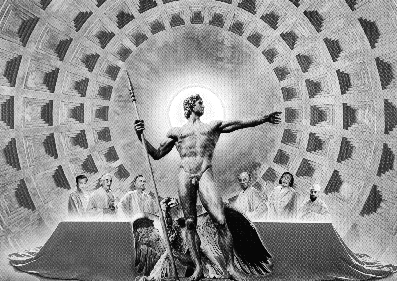
The original painting "The Last Supper of Alexander the Great" by the French painter Pierre Peyrolle.

The original painting "The Last Supper of Alexander the Great" by the French painter Pierre Peyrolle.
The Order of Alexander the Great for Art and Science honors the Spirit and the positive deeds of Alexander the Great (356-323 B.C.) for the advancement of mankind and the remembrance of the outstanding figures who, as Kings, Emperors, Popes, political leaders, scientists and artists, carried forth his goals. This democratic Order is a free society, without materialistic interests, of those who feel dedicated to the Spirit of Alexander and who live their lives accordingly, in private and in public. The Order makes awards to promote Fine Arts, Science, Classical Theater and Music, and expects its members to support these goals, according to their ability.
The Order has its roots in the time before the birth of Christ. It developed activities and circles in the second century A.D., when literature and poetry about Alexander started. The Order was established again by the West Europeans under the patronage of King Paul I of the Hellenes (1947-1964), reorganized in 1975 according to the Ordre Pour Le Merite, in the tradition of King Frederick II of Prussia, and democratically renewed in 1990 by Grandmaster Roger Peyrefitte in Paris.
The Order is dedicated to the international promotion of Freedom, Justice, and Peace through the cultural union of Science and the Arts. It's seat is located at Schloss Nörvenich, a 12th century castle in Germany.
Roger Peyrefitte, (Paris) a former diplomat and the most significant living French writer -- the author of an Alexander biography, is the Grandmaster of the Order. John Gilbert Bodenstein, (Germany) the Lord of Nörvenich Castle, is the Secretary of the Order. B. John Zavrel (USA), the founder-director of the Museum of European Art, is the Chancellor of the Order.
The Order has several classes of members. The highest class (Honorary Members) presently comprises about fifty world-wide scientists, artists and cultural leaders (usually over 45 years of age) who have attained eminence in their respective professions, and who have adhered to the cultural Spirit of Alexander. Among them are German rocket scientist Hermann Oberth, environmentalist the Prince of Wales, sculptor Arno Breker, former United States President Ronald Reagan, sculptor Kurt Arentz, writers Ernst Juenger and Roger Peyrefitte, and others. Honorary Members are also known as Knights of the Order.
New members are usually admitted as "novices." Novices are younger men and women who have not yet attained world eminence, but who show clear promise of eminence and of exemplifying the Spirit of Alexander in their private and public lives.
Potential new members (either Honorary Members or Novices) may be nominated by the existing Members, after which they will be evaluated by the Order for possible admission. After a period of several years, novices may become full Members, depending on their contributions to the society as well as to the Order.
American children are taught that Alexander the Great was a military leader and emperor who conquered the known world at a very young age. But European children are taught also that he was a cultural leader who advanced culture wherever he went. He built the city of Alexandria in Egypt and put in it a library which was the cultural center of the world for nearly a millennium, until destroyed by Caesar. Here were the (now lost) books of Democritus, "the laughing philosopher," which, from pure speculation, spelled out the a'tom, a further subdivision of our "atom," which we still seek as a "Higgs boson," or would be seeking, had we not canceled out our super-collider in Texas this year.
Half a century ago King Paul of Greece felt that this cultural Spirit of Alexander, which encouraged the non-materialistic cultural correlation of Science and the Arts, should be honored and that contemporary Artists and Scientists and cultural leaders should be similarly honored. Thus a very select group of some twenty-five eminent artists and scientists and cultural leaders throughout the world have been so honored.
Usually, when a new Honorary Member is admitted, he (or she) gives an "Alexander Dinner" for 12-24 guests, where one or more courses comprise food of the type Alexander would have eaten in the field. At the dinner the new member is presented with a membership document, and a medal bearing the head of Alexander the Great.
The prominent European journalist J.F. Bodenstein has been commissioned the the Order to write a book on the history, work, and mission of the Order. The book is scheduled to be published in the United States.
Each inductee into the Order is expected to live his or her life, in public and in private, in accordance with the "Spirit of Alexander" and to support the cultural goals of the Alexander Order to the best of their ability.
The Order is world-wide and is
devoted to the international promotion of Freedom, Justice, and Peace
through Science and the Arts, without regard to race, sex, or creed.
We in America hope that we can promote this Spirit of Alexander
through institutions such as the United States Museum of European
Art, located in Clarence, New York. By exhibiting fine works of art
and communicating the international Spirit behind each creation to
visitors and especially to American school children, perhaps we can
do our small part towards the Order's goals of world-wide Freedom,
Justice, and Peace.
For more information, contact
B. John Zavrel, OAG Chancellor
10545 Main Street, Clarence, New York 14031 E-mail: zavrel@meaus.com
in Europe:
John G. Bodenstein, OAG Secretary
Schloss Noervenich, 52388 Nörvenich, Germany.
Keep informed - join our newsletter:
Copyright 2001 West-Art
PROMETHEUS, Internet Bulletin for Art, Politics and Science.